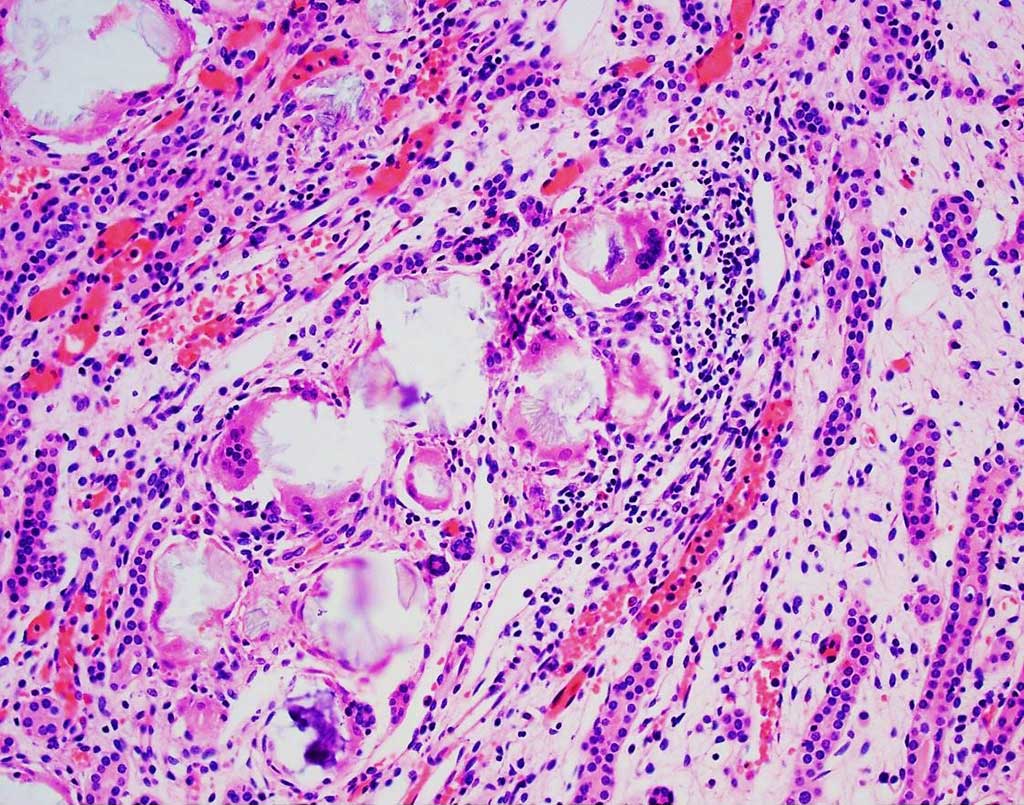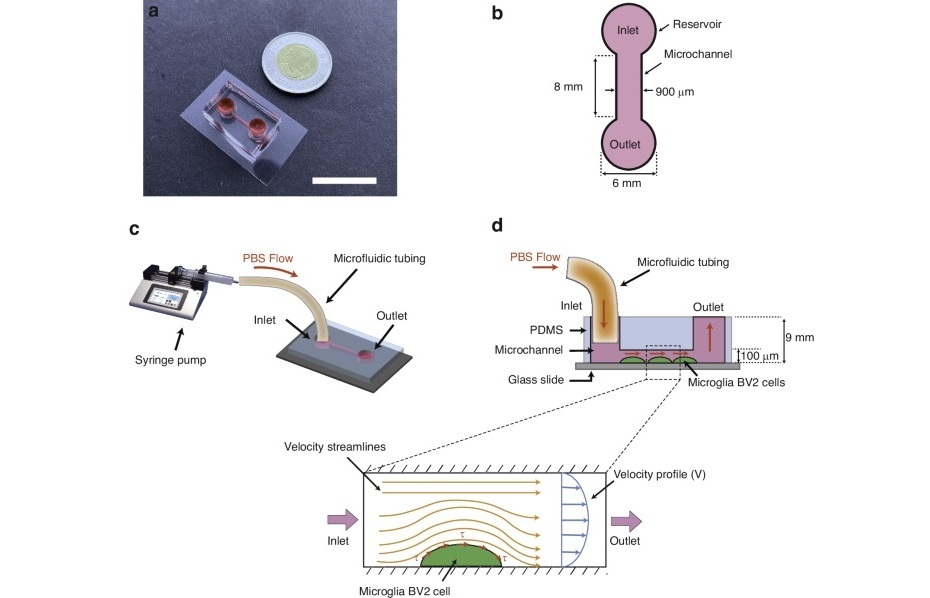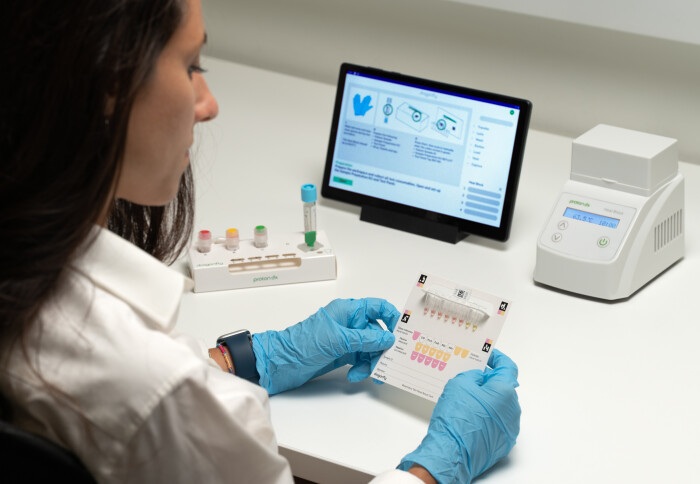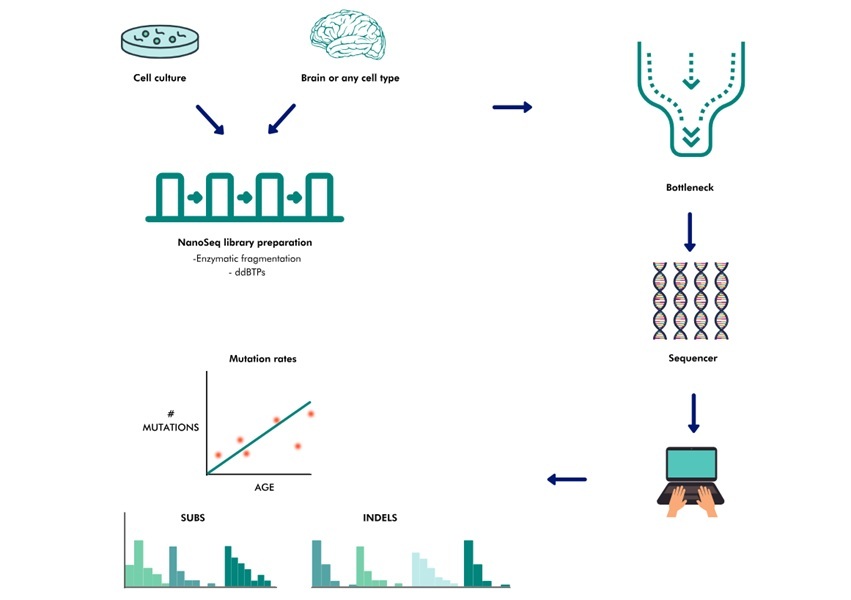Biomarker Panel Evaluated for Primary Hyperoxaluria Patients
|
By LabMedica International staff writers Posted on 27 Apr 2020 |

Image: Histology of multinucleated giant cells engulfing calcium oxalate crystals from a patient with type 1 primary hyperoxaluria (Photo courtesy of Jonathan E. Zuckerman, MD, PhD).
Primary hyperoxaluria (PH) is a group of autosomal recessive disorders characterized by recurrent urinary stones and nephrocalcinosis. Roughly half of PH patients present with advanced chronic kidney disease (CKD) at the time of diagnosis.
Three forms of PH have been recognized based on the underlying genetic defects. Mutations in the AGXT, GRHPR, and HOGA1 genes cause primary hyperoxaluria types 1, 2, and 3, respectively. The main biochemical defect in PH is overproduction of oxalate due to enzyme deficiencies, primarily in the liver. The excess oxalate must then be excreted by the kidney. In the kidney oxalate can combine with calcium within renal tubules leading to nephrocalcinosis and kidney stones.
Nephrologists and their colleagues from the Mayo Clinic (Rochester, MN, USA) enrolled 30 PH patients who had one or more biobanked urine specimens and no prior history of end stage renal disease (ESRD) or organ transplantation. A cohort of 47 non-stone forming adults in good general health without kidney disease or diabetes (22 women, 25 men, ages ranging from 23 to 77 years) who completed 24-hour urine collections on a free choice diet served as the adult control group to establish an adult reference range for the urine biomarkers.
The scientists used a panel of biomarkers that reflect different nephron sites and potential mechanisms of injury (clusterin, neutrophil gelatinase-associated lipocalin (NGAL), 8-isoprostane (8IP), monocyte-chemoattractant protein 1 (MCP-1), liver-type fatty acid binding protein (L-FABP), heart-type fatty acid binding protein (H-FABP), and osteopontin (OPN) were measured in 114 urine specimens from 30 PH patients over multiple visits. Generalized estimating equations were used to assess associations between biomarkers and 24 hour urine excretions, calculated proximal tubular oxalate concentration (PTOx), and estimated glomerular filtration rate (eGFR).
The team reported that mean (±SD) age at first visit was 19.5 ± 16.6 years with an estimated glomerular filtration rate (eGFR) of 68.4 ± 21.0 mL/min/1.73m2. After adjustment for age, sex, and eGFR, a higher urine MCP-1 concentration as measured by Quantikine Human chemokine (C-C motif) ligand 2/ monocyte chemoattractant protein-1 (CCL2/MCP1) kit (R&D Systems, Minneapolis, MN, USA) and MCP-1/creatinine ratio was positively associated with calcium oxalate supersaturation (CaOx SS). Higher urine NGAL and NGAL/creatinine as well as OPN and OPN/creatinine were associated with higher eGFR. 8IP was negatively associated with PTOx and urinary Ox, but positively associated with CaOx SS.
The authors concluded that although the mechanisms are not entirely clear, CaOx crystallization in renal tubules has been considered as one of the critical therapeutic targets in the development of new therapeutic approach to treat PH. The association between urine level of MCP-1 and CaOx crystallization may suggest urine MCP-1 could be used as a marker to assist the evaluation for the effectiveness of treatments in PH patients. In addition, this association may suggest that MCP-1 signaling pathway might be in involved in the etiology of renal damage in PH. The study was published on April 15, 2020 in the journal BMC Nephrology.
Related Links:
Mayo Clinic
R&D Systems
Three forms of PH have been recognized based on the underlying genetic defects. Mutations in the AGXT, GRHPR, and HOGA1 genes cause primary hyperoxaluria types 1, 2, and 3, respectively. The main biochemical defect in PH is overproduction of oxalate due to enzyme deficiencies, primarily in the liver. The excess oxalate must then be excreted by the kidney. In the kidney oxalate can combine with calcium within renal tubules leading to nephrocalcinosis and kidney stones.
Nephrologists and their colleagues from the Mayo Clinic (Rochester, MN, USA) enrolled 30 PH patients who had one or more biobanked urine specimens and no prior history of end stage renal disease (ESRD) or organ transplantation. A cohort of 47 non-stone forming adults in good general health without kidney disease or diabetes (22 women, 25 men, ages ranging from 23 to 77 years) who completed 24-hour urine collections on a free choice diet served as the adult control group to establish an adult reference range for the urine biomarkers.
The scientists used a panel of biomarkers that reflect different nephron sites and potential mechanisms of injury (clusterin, neutrophil gelatinase-associated lipocalin (NGAL), 8-isoprostane (8IP), monocyte-chemoattractant protein 1 (MCP-1), liver-type fatty acid binding protein (L-FABP), heart-type fatty acid binding protein (H-FABP), and osteopontin (OPN) were measured in 114 urine specimens from 30 PH patients over multiple visits. Generalized estimating equations were used to assess associations between biomarkers and 24 hour urine excretions, calculated proximal tubular oxalate concentration (PTOx), and estimated glomerular filtration rate (eGFR).
The team reported that mean (±SD) age at first visit was 19.5 ± 16.6 years with an estimated glomerular filtration rate (eGFR) of 68.4 ± 21.0 mL/min/1.73m2. After adjustment for age, sex, and eGFR, a higher urine MCP-1 concentration as measured by Quantikine Human chemokine (C-C motif) ligand 2/ monocyte chemoattractant protein-1 (CCL2/MCP1) kit (R&D Systems, Minneapolis, MN, USA) and MCP-1/creatinine ratio was positively associated with calcium oxalate supersaturation (CaOx SS). Higher urine NGAL and NGAL/creatinine as well as OPN and OPN/creatinine were associated with higher eGFR. 8IP was negatively associated with PTOx and urinary Ox, but positively associated with CaOx SS.
The authors concluded that although the mechanisms are not entirely clear, CaOx crystallization in renal tubules has been considered as one of the critical therapeutic targets in the development of new therapeutic approach to treat PH. The association between urine level of MCP-1 and CaOx crystallization may suggest urine MCP-1 could be used as a marker to assist the evaluation for the effectiveness of treatments in PH patients. In addition, this association may suggest that MCP-1 signaling pathway might be in involved in the etiology of renal damage in PH. The study was published on April 15, 2020 in the journal BMC Nephrology.
Related Links:
Mayo Clinic
R&D Systems
Latest Immunology News
- Blood Test Tracks Treatment Resistance in High-Grade Serous Ovarian Cancer
- Luminescent Probe Measures Immune Cell Activity in Real Time
- Blood-Based Immune Cell Signatures Could Guide Treatment Decisions for Critically Ill Patients
- Novel Tool Predicts Most Effective Multiple Sclerosis Medication for Patients
- Companion Diagnostic Test for CRC Patients Identifies Eligible Treatment Population
- Novel Tool Uses Deep Learning for Precision Cancer Therapy
- Companion Diagnostic Test Identifies HER2-Ultralow Breast Cancer and Biliary Tract Cancer Patients
- Novel Multiplex Assay Supports Diagnosis of Autoimmune Vasculitis
- Blood Test Predicts Immunotherapy Efficacy in Triple-Negative Breast Cancer
- Simple Genetic Testing Could Predict Treatment Success in Multiple Sclerosis Patients
- Novel Gene Signature Predicts Immunotherapy Response in Advanced Kidney Cancers
- New Technology Deciphers Immune Cell Communication to Predict Immunotherapy Response
- AI Model Accurately Predicts MSI Tumor and Immune Checkpoint Inhibitor Responsiveness
- Precision Tool Predicts Immunotherapy Treatment Failure in Melanoma Patients
- Paper-Based Device Accurately Detects Immune Defects in 10 Minutes
- New AI System Uncovers Hidden Cell Subtypes to Advance Cancer Immunotherapy
Channels
Molecular Diagnostics
view channel
Portable Label-Free Device Tracks Alzheimer's Disease in Real Time
Alzheimer’s disease is marked by the accumulation of toxic protein fragments in the brain that damage nerve cells and impair memory. Detecting and tracking these early changes remains a major challenge,... Read more
Liquid Biopsy Test Enables Early Detection of ICI-Related Myocarditis
Cancer treatments have advanced significantly in recent years, but they can still trigger severe and sometimes fatal side effects. Immune checkpoint inhibitors (ICIs), which have transformed cancer therapy,... Read moreHematology
view channel
Viscoelastic Testing Could Improve Treatment of Maternal Hemorrhage
Postpartum hemorrhage, severe bleeding after childbirth, remains one of the leading causes of maternal mortality worldwide, yet many of these deaths are preventable. Standard care can be hindered by delays... Read more
Pioneering Model Measures Radiation Exposure in Blood for Precise Cancer Treatments
Scientists have long focused on protecting organs near tumors during radiotherapy, but blood — a vital, circulating tissue — has largely been excluded from dose calculations. Each blood cell passing through... Read more
Platelets Could Improve Early and Minimally Invasive Detection of Cancer
Platelets are widely recognized for their role in blood clotting and scab formation, but they also play a crucial role in immune defense by detecting pathogens and recruiting immune cells.... Read more
Portable and Disposable Device Obtains Platelet-Rich Plasma Without Complex Equipment
Platelet-rich plasma (PRP) plays a crucial role in regenerative medicine due to its ability to accelerate healing and repair tissue. However, obtaining PRP traditionally requires expensive centrifugation... Read moreImmunology
view channel
Blood Test Tracks Treatment Resistance in High-Grade Serous Ovarian Cancer
High-grade serous ovarian cancer (HGSOC) is often diagnosed at an advanced stage because it spreads microscopically throughout the abdomen, and although initial surgery and chemotherapy can work, most... Read more
Luminescent Probe Measures Immune Cell Activity in Real Time
The human immune system plays a vital role in defending against disease, but its activity must be precisely monitored to ensure effective treatment in cancer therapy, autoimmune disorders, and organ transplants.... Read more
Blood-Based Immune Cell Signatures Could Guide Treatment Decisions for Critically Ill Patients
When a patient enters the emergency department in critical condition, clinicians must rapidly decide whether the patient has an infection, whether it is bacterial or viral, and whether immediate treatment... Read moreMicrobiology
view channel
Fast Noninvasive Bedside Test Uses Sugar Fingerprint to Detect Fungal Infections
Candida bloodstream infections are a growing global health threat, causing an estimated 6 million cases and 3.8 million deaths annually. Hospitals are particularly vulnerable, as weakened patients after... Read more
Rapid Sepsis Diagnostic Device to Enable Personalized Critical Care for ICU Patients
Sepsis is a life-threatening condition that occurs when the body’s response to infection spirals out of control, damaging organs and leading to critical illness. Patients often arrive at intensive care... Read morePathology
view channel
AI Improves Cervical Cancer Screening in Low-Resource Settings
Access to cervical cancer screening in low- and middle-income countries remains limited, leaving many women without early detection for this life-threatening disease. The lack of access to laboratories,... Read more
New Multi-Omics Tool Illuminates Cancer Progression
Tracking how cancers evolve into more aggressive and therapy-resistant forms has long been a challenge for researchers. Many current tools can only capture limited genetic information from tumor samples,... Read moreTechnology
view channel
Acoustofluidic Device to Transform Point-Of-Care sEV-Based Diagnostics
Rapid and sensitive detection of small extracellular vesicles (sEVs)—key biomarkers in cancer and organ health monitoring—remains challenging due to the need for multiple preprocessing steps and bulky... Read more
AI Algorithm Assesses Progressive Decline in Kidney Function
Chronic kidney disease (CKD) affects more than 700 million people worldwide and remains a major global health challenge. The condition often progresses silently, and many patients remain undiagnosed until... Read more
Taste-Based Influenza Test Could Replace Nasal Swabs with Chewing Gum
Influenza is one of the most dangerous infectious diseases worldwide, claiming around half a million lives each year. What makes it particularly insidious is that flu viruses are contagious even before... Read more
3D Micro-Printed Sensors to Advance On-Chip Biosensing for Early Disease Detection
Early-stage disease diagnosis depends on the ability to detect biomarkers with exceptional sensitivity and precision. However, traditional biosensing technologies struggle with achieving this at the micro-scale,... Read moreIndustry
view channelHologic to be Acquired by Blackstone and TPG
Hologic (Marlborough, MA, USA) has entered into a definitive agreement to be acquired by funds managed by Blackstone (New York, NY, USA) and TPG (San Francisco, CA, USA) in a transaction valued at up to... Read more
Bio-Techne and Oxford Nanopore to Accelerate Development of Genetics Portfolio
Bio-Techne Corporation (Minneapolis, MN, USA) has expanded its agreement with Oxford Nanopore Technologies (Oxford, UK) to broaden Bio-Techne's ability to develop a portfolio of genetic products on Oxford... Read more
Terumo BCT and Hemex Health Collaborate to Improve Access to Testing for Hemoglobin Disorders
Millions of people worldwide living with sickle cell disease and other hemoglobin disorders experience delayed diagnosis and limited access to effective care, particularly in regions where testing is scarce.... Read more















